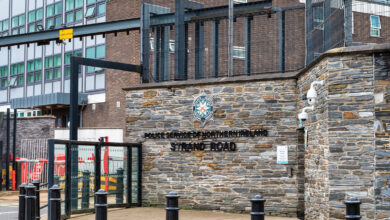Justice Bill under scrutiny
 agendaNi considers the main proposals within the current Justice Bill. Its main aim is to speed up court processes and improve protections for victims.
agendaNi considers the main proposals within the current Justice Bill. Its main aim is to speed up court processes and improve protections for victims.
Court procedures
At present, Northern Ireland has seven county court and 21 magistrates’ court districts. The department considered aligning the court districts with the 11 new council areas but opted for the more radical option of creating a single territorial jurisdiction for Northern Ireland.
Committal for trial proceedings take place before a magistrate. The Bill would speed up the process by excluding oral evidence from witnesses at that stage – although the defendant would still be able to make representations on their own behalf.
Magistrates would be able to transfer cases directly to the crown court where the defendant has formally indicated that he or she intends to plead guilty, and in murder and manslaughter cases.
The Bill would allow expert witnesses, witnesses from outside the UK, and patients detained on mental health grounds to use live video links in court proceedings. Live links would also be extended to committal proceedings, breach proceedings, and magistrates’ court cases over weekends and public holidays. Separately, a change in the Parole Commissioners’ rules would allow live links for their oral hearings. The age for being excused from jury service would be raised from 65 to 70. The minimum age would remain at 18.
The department wants to introduce case management procedure rules to reduce avoidable delay in the court system. These will set out when the various stages of a case should be completed.
Protecting victims
Victim personal statements give people affected by crime an opportunity (in writing) to describe the effects of the crime upon them, express their views, and indicate whether or not they require any support. The Bill would formally recognise the statements in legal terms. Some victims have wanted to read out their statements in court, the department has decided against this as it can make victims feel more vulnerable and self-conscious after the hearing.
Violent offences prevention orders place restrictions on adult offenders who are at risk of causing serious violent harm to others. The orders were introduced in England and Wales in 2008 and their introduction in Northern Ireland is strongly supported by the PSNI and Probation Board. The orders would last between two and five years and may be imposed on conviction or following an application by the Chief Constable.
Criminal records
The Bill allows for the electronic updating and transfer of criminal records and aims to streamline the system by reducing the number of certificates from two to one (at the standard and enhanced levels).
Self-employed persons would also be able to apply for and obtain enhanced criminal record certificates.
Two age limits are introduced: a general bar on carrying out criminal records checks on children aged under 16; and a minimum age of 18 for persons requesting a check.
Prosecutorial fines
Under this arrangement, prosecutors would be able to give minor offenders the choice of a fine (up to £200) or a prosecution in court. This, for example, could be used to obtain compensation after cases of criminal damage. An offender who pays the fine would avoid having the offence placed on a formal criminal record but the fines would be kept on a separate record which could be taken into account if he or she offends again.
Early guilty pleas
In certain cases, courts would be required to indicate the sentence which would have been imposed if a guilty plea had been entered at earliest reasonable opportunity. This would apply where the defendant did not at any stage of the proceedings plead guilty to the offence or where the court concludes that his or her plea of guilty was not entered (or given) at the earliest reasonable opportunity. Controversially, the court would disregard an initial plea of guilty (or an indication to plead guilty) which is subsequently changed to a plea of not guilty. The solicitor would also have a duty to advise his or her client about the advantages of entering an early guilty plea.
Assembly debate
The Bill was debated in detail at its second stage on 24 June last year and the most detailed analysis came from barristers Alban Maginness and Jim Allister. Maginness regretted the ending of the historic divisions for the courts and the abolition of the title of resident magistrate, which has existed since 1814. Maginness also questioned the complete abolition of evidence on oath at the committal stage as a failure to test evidence at that point could cause delays later in the case.
Allister warned that a single magistrates’ court jurisdiction could allow cases to be moved between court houses even though this may be inconvenient for victims and witnesses. He added that witness statements can be “quite self-serving” and should be cross-examined at an early stage. The prosecutorial fine system seemed “to be wide open to abuse” as offenders could choose to avoid prosecution.
Committee stage
The Justice Committee is considering the Bill and working to a deadline of 27 March this year. The department’s proposed amendments mainly aim to improve the sharing of information about victims’ services and criminal records.
Attorney General John Larkin is also seeking an amendment which would allow his office to obtain papers and other information when considering whether to direct an inquest. His main interest is in investigating deaths where medical error is alleged.
A separate amendment on restricting abortions to Health Service premises was brought forward by Jim Wells as a private member in July. Abortion is an area of criminal law under existing legislation. The proposal is similar to one brought forward by Paul Givan in March 2013. It received a majority of votes (53-40) but was blocked by a petition of concern.





